Basic Linux/Unix Commands Cheat Sheet By Emre Özkan 17 March 18 PERMISSION EXAMPLE U G W rwx rwx rwx chmod 777 filename rwx rwx rx chmod 775 filename rwx rx rx chmod 755 filename rw rw r chmod 664 filename rw r r chmod 644 filename # NOTE Use 777 sparingly!Linux Commands Cheat Sheet PDF If you prefer having all the commands on a onepage reference sheet, we created a helpful Linux command line cheat sheet You can save the list of linux commands in PDF format by clicking the Download Linux Cheat Sheet button below DOWNLOAD Linux Cheat SheetSome useful diff tools for Linux 8 Best File Comparison and Difference (Diff) Tools for Linux dir Command dir command works like Linux ls command, it lists the contents of a directory $ dir dmidecode Command dmidecode command is a tool for retrieving hardware information of any Linux system It dumps a computer's DMI (aka SMBIOS) table

The Linux Command Line Cheat Sheet Network World
Linux permissions cheat sheet pdf
Linux permissions cheat sheet pdf-Home AIX Basic Linux/Unix Commands Cheat Sheet AIX;Home AIX Basic Linux/Unix Commands Cheat Sheet AIX;
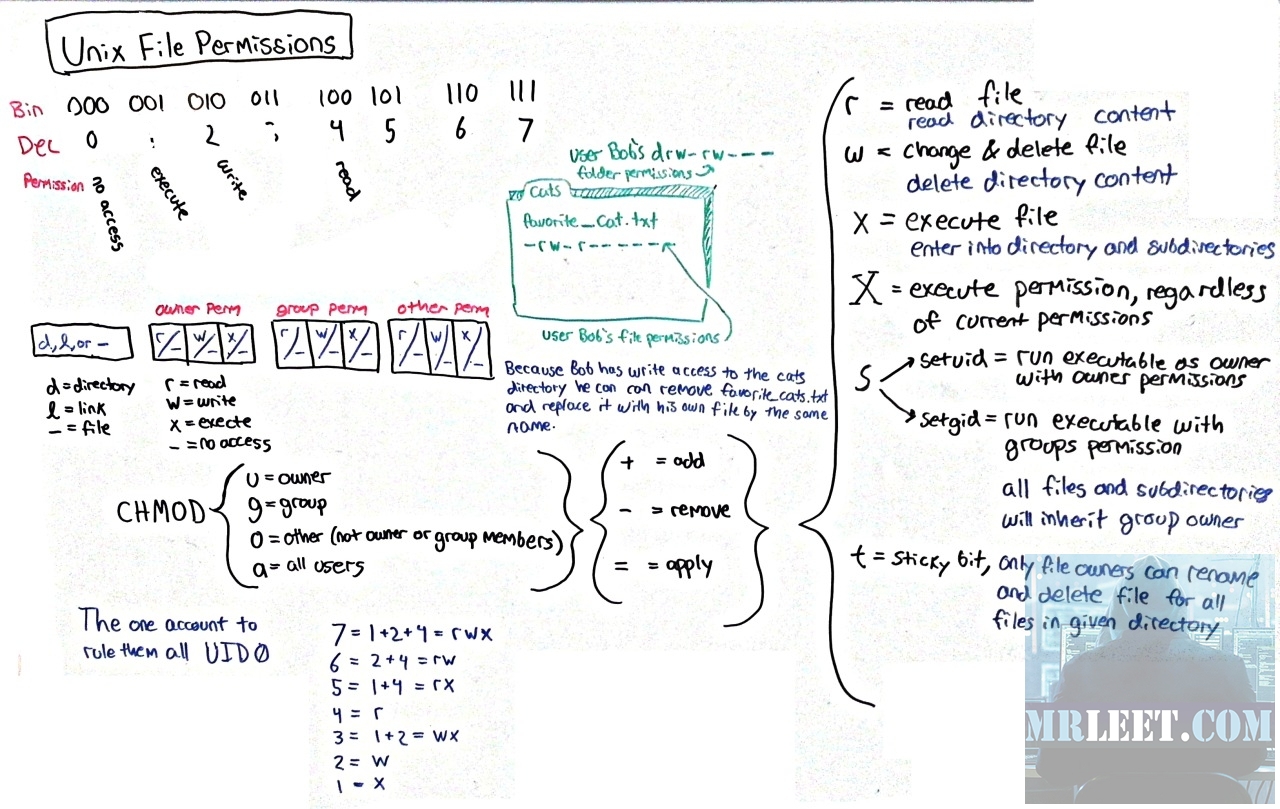


Collection Of Latest Picturess Useful In Pentesting Mrleet
Linux – Command Cheat Sheet File Commands ls list directory ls al formatted listing with hidden files ls ltr formatted listing ordered by time chmod 777 read, write, execute for all chmod 755 rwx for owner, rx for group and world For more options, see man chmod chown usergroup file change the owner and group for a fileLinux Terminal The Ultimate Cheat Sheet Mauro Garcia ・ Jan 25 ・ 15 min read #linux #terminal #beginners Permissions Change file mode bits command (chmod) Changing permissions in Linux is an extensive topic that deserves its own post But I decided to include a few examples that can come in handySome useful diff tools for Linux 8 Best File Comparison and Difference (Diff) Tools for Linux dir Command dir command works like Linux ls command, it lists the contents of a directory $ dir dmidecode Command dmidecode command is a tool for retrieving hardware information of any Linux system It dumps a computer's DMI (aka SMBIOS) table
It is a book, not a distro It describes step by step, how to build a Linux system If you follow this book and everything goes right, you will have a running Linux in the end To my mind, it is a good way to get a feeling for Linux, you get your hands on every package, that is more or less necessaryLinux File Permissions, chmod, & umask;RedHat Linux Cheat Sheet Common RedHat Commands chmod You can change file permissions in RedHat with the 'chmod' command You can use it to assign read, write, or execute permissions to a file Here are a few examples Create a test file then execute them all from the top down to see what happens The 'ls l filenametxt' command
Linux Chmod Permissions Cheat Sheet Set the permissions for a file or directory byOr, to add read and write permissions for the group that owns the file, you would run $ chmodAs you see below, whether is in Linux or macOS, that couldn't be easier!



Systemctl Start Stop Service How To Setup Upstart Script And Respawn Process In Ubuntu Centos Redhat Linux Crunchify


I Made This Chmod Cheat Sheet And Thought It Might Be Useful Linux4noobs
What is Linux From Scratch?Unix Cheat Sheet Here are some of the most used commands in Unix and their action To login to your account login Alex chmod mode filename chmod mode directory_name Setting access permissions numerically There is a shorthand way of setting permissions by using octal numbers Read permission is given the value 4, write permission theA cheat sheet for UNIXbased systems directory and file permissions, including CHMOD examples as well as an explanation as to what it all means lansana/unixpermissionscheatsheet
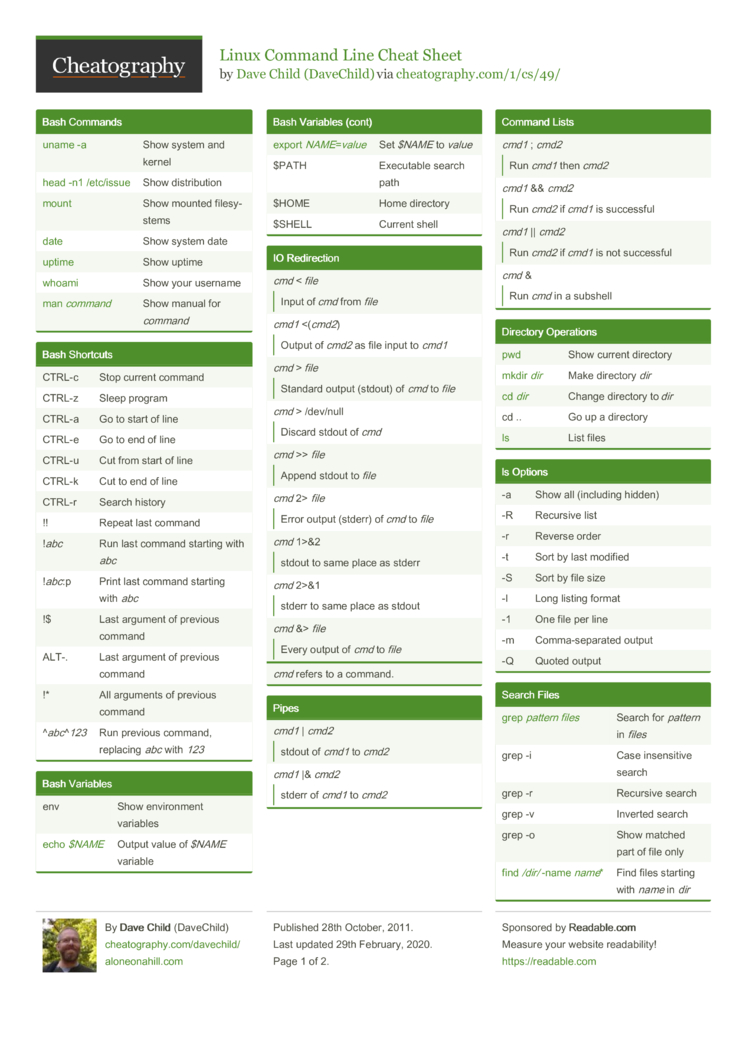


Linux Command Line Cheat Sheet By Davechild Download Free From Cheatography Cheatography Com Cheat Sheets For Every Occasion



Hfrojnrokionhm
16k votes, 128 comments 601k members in the linux community All things Linux and GNU/Linux this is neither a community exclusively about theSome useful diff tools for Linux 8 Best File Comparison and Difference (Diff) Tools for Linux dir Command dir command works like Linux ls command, it lists the contents of a directory $ dir dmidecode Command dmidecode command is a tool for retrieving hardware information of any Linux system It dumps a computer's DMI (aka SMBIOS) tableIn Unix and Unixlike operating systems, chmod is the command and system call which is used to change the access permissions of file system objects (files and directories) It is also used to change special mode flags The request is filtered by the umask The name is an abbreviation of change mode chmod Cheat Sheet List Chmod chart


Cheat Sheet All Cheat Sheets In One Page


Cheat Sheet All Cheat Sheets In One Page
TuxArena Linux Cheat Sheet General Purpose Commands whereis locate the binary, source and manual page files for a command chmod change file mode bits The following shows the standard filesystem hierarchy on a Linux system, according to the Filesystem Hierarchy Standard /bin essential user command binaries (eg bash, bzip2, catCheat Sheet Linux is the first opensource operating system That means anyone can download the code and customize it as per one's need Linux doesn't need to rebooted periodically or slow down due to memory leaks It gives the best performance and can handle a large number of users simultaneouslyChmod octal file – change the permissions of file to octal, which can be found separately for user, group, and world by adding 4 – read (r) 2 – write (w) 1 – execute (x) Examples chmod 777 – read, write, execute for all chmod 755 – rwx for owner, rx for group and world For more options, see man chmod SSH



Ftp Commands Cheat Sheet Page 1 Line 17qq Com


Some Linux Commands Cheat Sheet Linux
Linux Commands Cheat Sheet 1 – SYSTEM INFORMATION 2 – HARDWARE INFORMATION 3 – PERFORMANCE MONITORING AND STATISTICS 4 – USER INFORMATION AND MANAGEMENT 5 – FILE AND DIRECTORY COMMANDS If destination exists, copy source_directory into destination, otherwise create 6 – PROCESS MANAGEMENTSpecial File Permissions (setuid, setgid and Sticky Bit) Converted by Wesley Hill;Fatmawati Achmad Zaenuri/com Control who can access files, search directories, and run scripts using the Linux's chmod command This command modifies Linux file permissions, which look complicated at first glance but are actually pretty simple once you know how they work



Chmod Chart Yerse



Shell Cheat Sheet Page 1 Line 17qq Com
Home AIX Basic Linux/Unix Commands Cheat Sheet AIX;Download Now Basic Linux Commands Cheat Sheet Linux System Administration Skills Assessment So to understand this concept in a simpler way, think of file permissions as a 3x3 matrix, where owners, groups, and others each have r, w, and x settingsThe command chmod arwx is equivalent to chmod ugorwx Recursive Like many other Linux commands, chmod has a recursive argument, R, which allows you to operate on a directory and its contents recursively By recursive, It is meant that the command will attempt to operate on all objects below the specified directory rather than just the



Linux Command Line Cheat Sheet Pdf Docsity
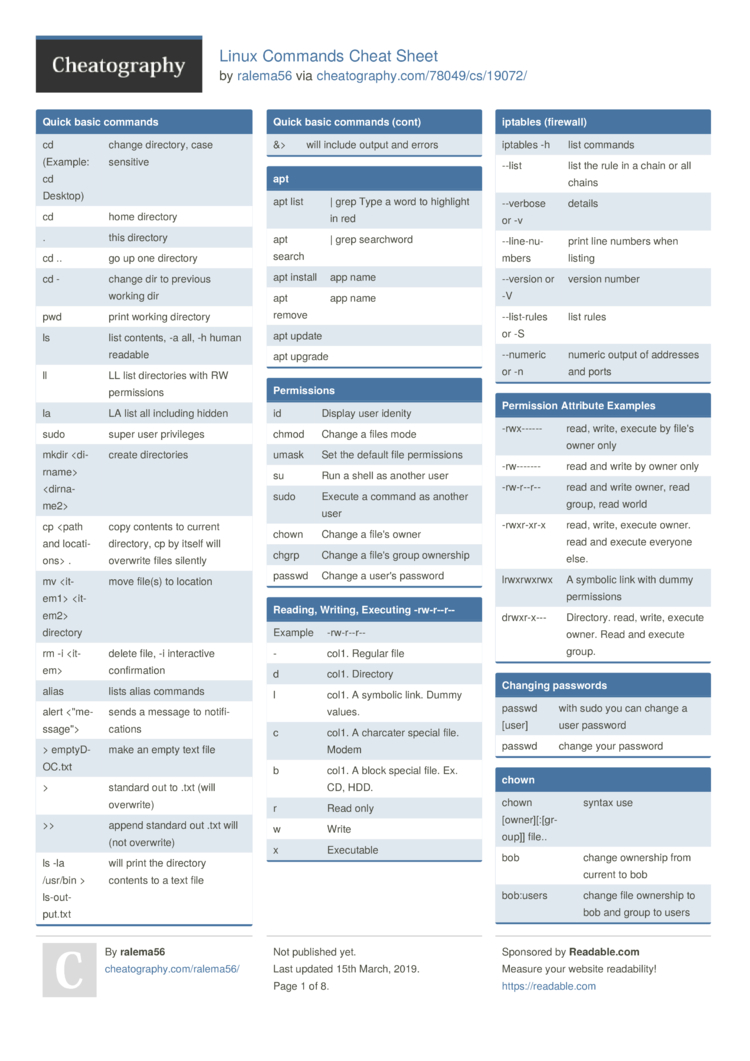


Linux Commands Cheat Sheet By Ralema56 Download Free From Cheatography Cheatography Com Cheat Sheets For Every Occasion
Unix Cheat Sheet Here are some of the most used commands in Unix and their action To login to your account login Alex chmod mode filename chmod mode directory_name Setting access permissions numerically There is a shorthand way of setting permissions by using octal numbers Read permission is given the value 4, write permission theCHMOD Cheat Sheet CHMOD Cheat Sheet Dan Flood December 16, 13 Tech Stuff, Unix and Linux Leave a Comment I find myself having to pause and remember exactly what Unix permissions translate to in functionality so posted this handy chart to use Unix or any *nix uses octal for permissions – it's pretty simple once you get the chart intoPipes and Redirection (You pipe a command to another command, and redirect it to a file) {command} > {file} Redirect output to a file, eg ls > listtxt writes directory to file {command} >> {file} Append output to an existing file, eg cat update >> archive adds update to end of archive {command} < {file}
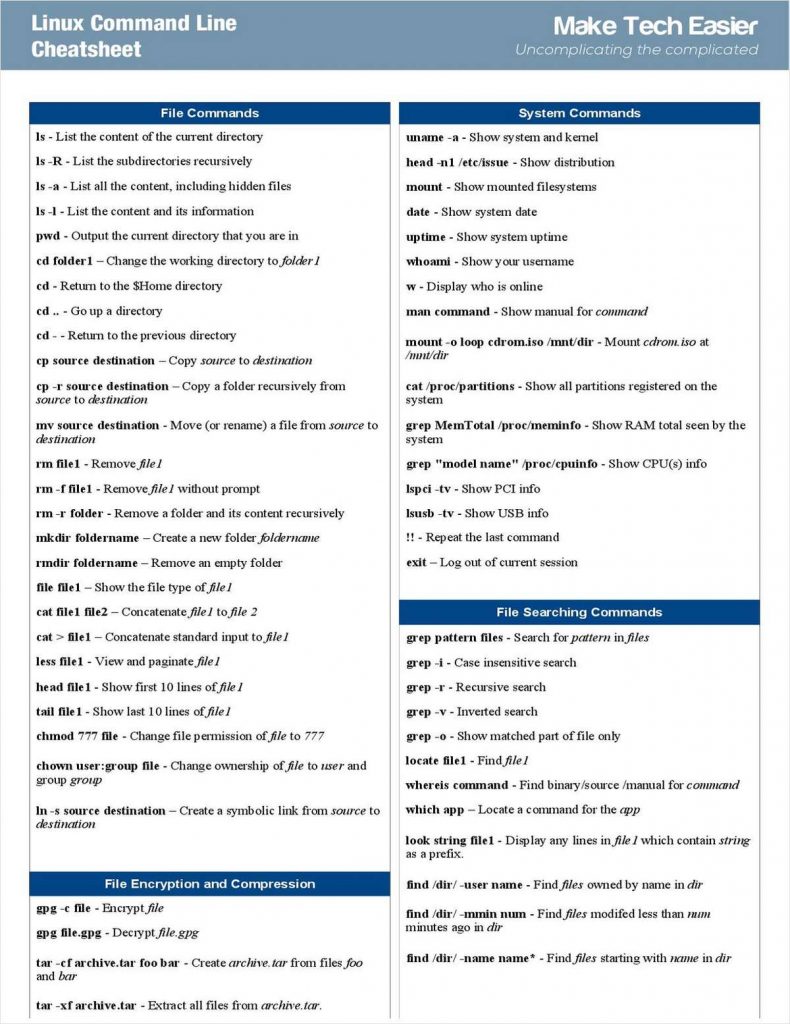


Free Ubuntu E Books Linux Books Download For Free
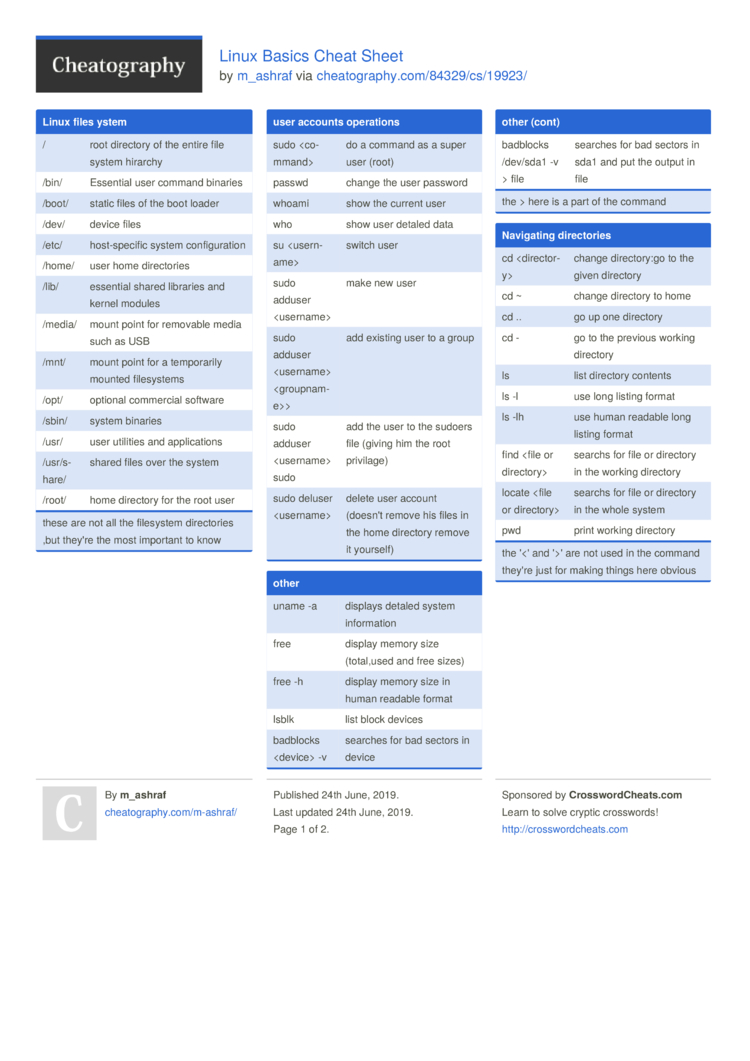


Linux Basics Cheat Sheet By M Ashraf Download Free From Cheatography Cheatography Com Cheat Sheets For Every Occasion
The following video shows you how to use chmod and chown to change up file permissions It also goes over the various settings you can apply to files with chmod Here is a quick cheat sheet for chmod 7 = 421 (read/write/execute) 6 = 42 (read/write) 5 = 41 (read/execute) 4 = 4 (read) 3LINUX COMMANDS CHEAT SHEET System dmesg => Displays bootup messages cat /proc/cpuinfo => Displays more information about CPU eg model, model name, cores, vendor id chmod octal filename => Change file permissions of the file to octal Example chmod 777 /data/ testcDownload Now Basic Linux Commands Cheat Sheet Linux System Administration Skills Assessment So to understand this concept in a simpler way, think of file permissions as a 3x3 matrix, where owners, groups, and others each have r, w, and x settings
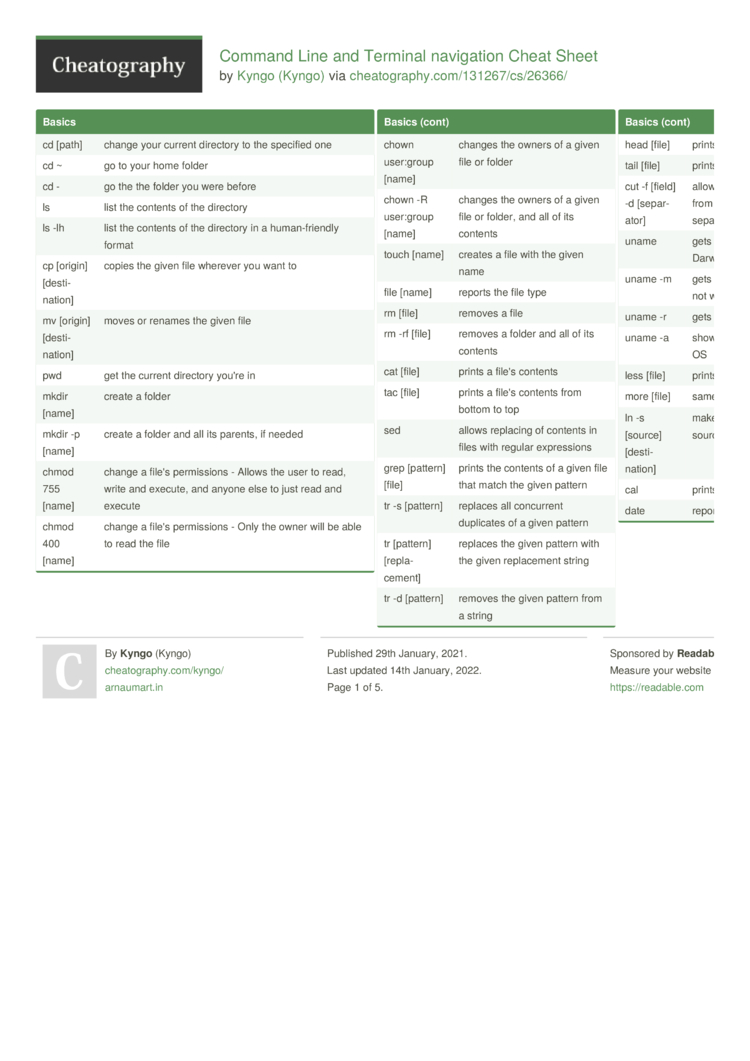


Command Line And Terminal Navigation Cheat Sheet By Kyngo Download Free From Cheatography Cheatography Com Cheat Sheets For Every Occasion



Linux File Command Page 1 Line 17qq Com
Linux Commands Cheat Sheet show bootup messages show CPU information show free and used memory (m flag indicates memory in MB) list information about hardware chmod 755 file_name chmod 766 file_name chown user file_name chown user group file_name give read, write, and executeBasic Linux/Unix Commands Cheat Sheet By Emre Özkan 17 March 18 PERMISSION EXAMPLE U G W rwx rwx rwx chmod 777 filename rwx rwx rx chmod 775 filename rwx rx rx chmod 755 filename rw rw r chmod 664 filename rw r r chmod 644 filename # NOTE Use 777 sparingly!Chmod 775 file Change mode of file to 775 chmod R 600 folder Recurs ively chmod folder to 600 chown usergroup file Change file owner to user and group to group File Permission Numbers First digit is owner permis sion, second is group and third is everyone Calculate permission digits by adding numbers below 4 read (r) 2 write (w) 1 execute (x)



Linux Command Line Cheat Sheet



Command Line Cheat Sheet Learn Version Control With Git Cheat Sheets Medical Technology Cheating
Actually, to create a barebones Linux server install there are efficiently over 1,000 different commands The impressive thing is that most people only need to use a very small subset of those commands Below you'll find a Kali Linux command cheat sheet that breaks down some of the considerably commonly used commands by categoryHere in this cheat sheet, Linux commands are categorized into different sections according to its usage We have designed all the commands in a nice background color I have added had both pdf and image (png) format of the cheat sheet chmod octal filename Change file permissions of the file to octalLinux Command Cheat Sheet sudo command nohup command man command command & >> fileA > fileA echo n xargs 1>2& fg %N jobs ctrlz Basic commands Pipe (redirect) output run < command> in superuser mode run < command> immune to hangup signal display help pages of < command> run < command> and send task to background append to fileA, preserving
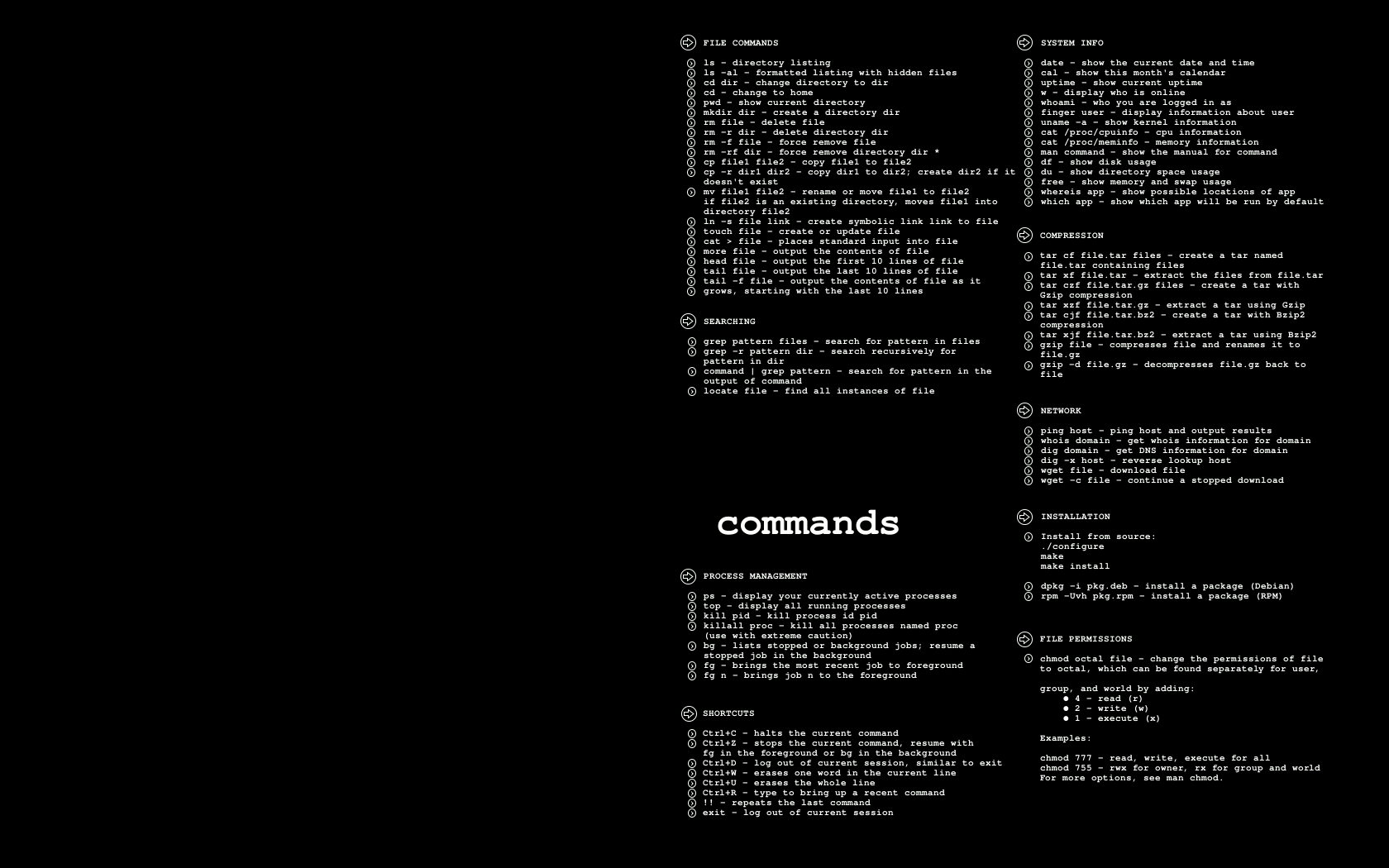


Text Linux Cheatsheet Commands



Cheatsheet Unix Linux Shell Linux Shell Unix Programming Linux
In this cheat sheet tutorial I have consolidated a list of Linux commands with examples and man page link to give you an overview on Linux day to day usage We know Linux is one of the preferred choice for most of the IT domains so having basic knowledge of Linux is mandatory for everyoneVariables and Path You can define variables in your computer shell in two ways Change the permissions and the owner of a file or directory with chmod and chown respectively Search for files I hope you like this cheat sheet If you have any questions orYou can modify and improve this cheat sheet here



Linux Cheat Sheet Commands Pdf Download Printable



Kubernetes Cheat Sheet R1v1 Information Technology Management Operating System Technology
They are Basic Linux commands, File permission commands, Environment variables commands, User management commands, Networking commands, Process commands, VI Editing commands, Other Commands We are giving a detailed explanation for each and every Linux command with their examples for easy learning in the below sectionsLinux Cheat Sheet Commands In this page, you will find Basic Linux Commands and important ones in the title of Linux Cheat Sheet CommandsAs you know Linux is widely used in Networking World Network Engineers and system Administrators uses this important operation system commands a lot in their Daily routine or critical operation activitiesTuxArena Linux Cheat Sheet General Purpose Commands whereis locate the binary, source and manual page files for a command chmod change file mode bits The following shows the standard filesystem hierarchy on a Linux system, according to the Filesystem Hierarchy Standard /bin essential user command binaries (eg bash, bzip2, cat
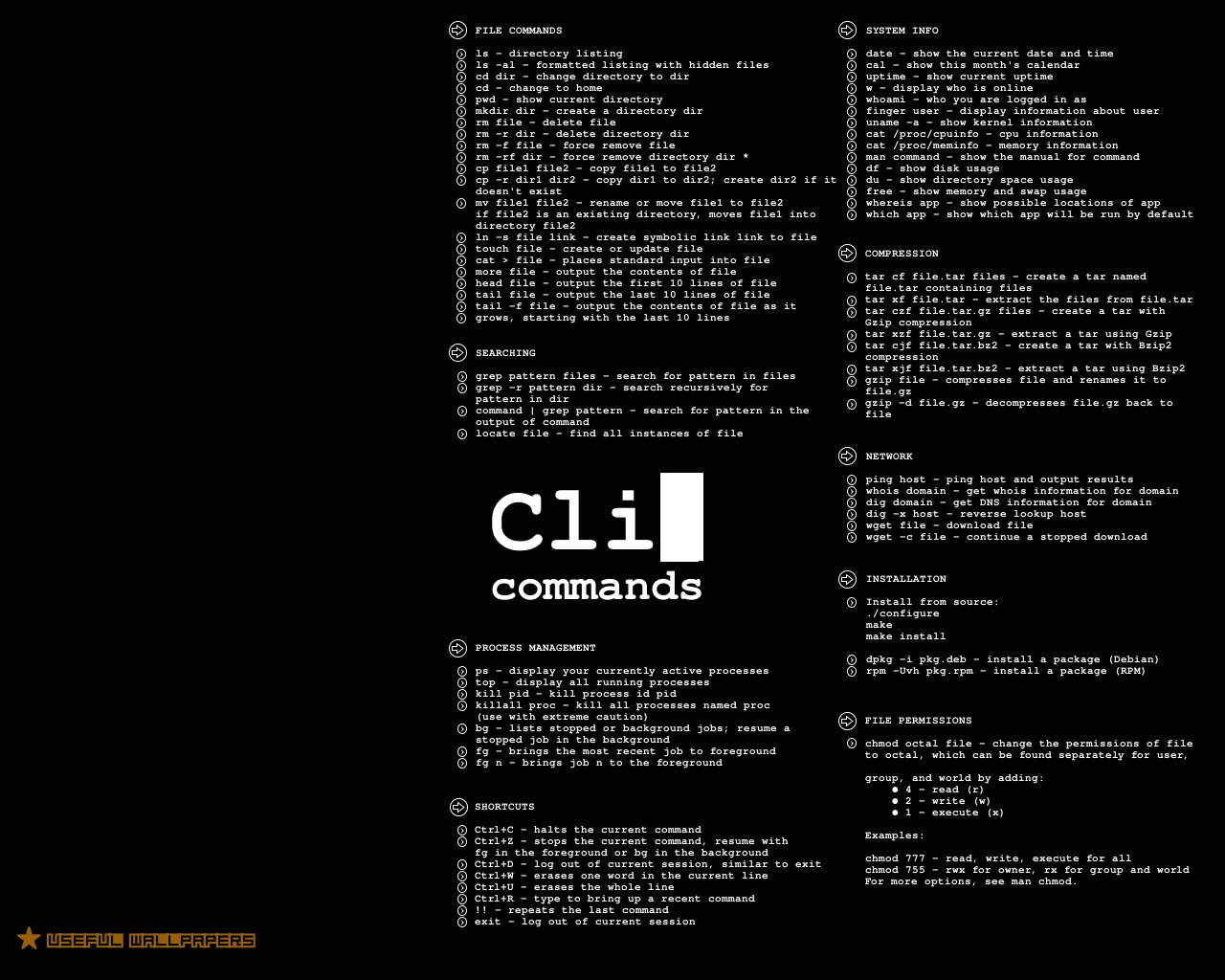


Very Handy Linux Cli Cheat Sheet
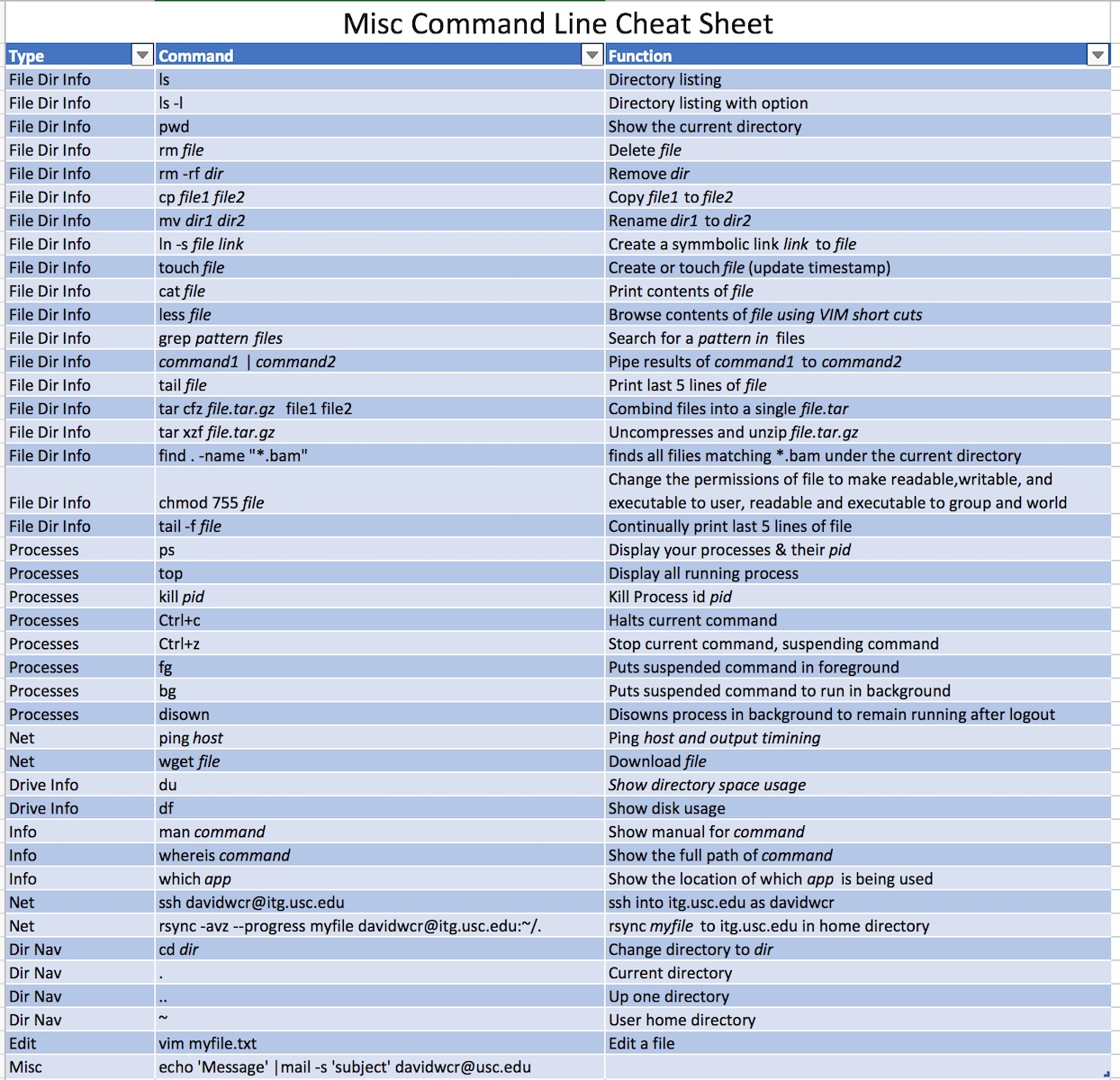


Command Line Bash Department Of Translational Genomics
Understanding and Setting UNIX File Permissions;To supplement the courses in our Cyber Security Career Development Platform, here is a Linux Command Line Cheat Sheet PDF download also available Table of Contents 1 SYSTEM INFORMATION 2 HARDWARE INFORMATION 3 PERFORMANCE MONITORING AND STATISTICS 4 USER INFORMATION AND MANAGEMENT 5 FILE AND DIRECTORY COMMANDS 6 PROCESS MANAGEMENT 7Linux is a open source operating system based on linux kernel Since it is free and opensource, that means any developer can simply change anything in Linux and redistribute it !



Nano Editor Keyboard Shortcuts By Bipinthite Http Www Cheatography Com Bipinthite Cheat Sheets Nano Editor Cheatshee Keyboard Shortcuts Editor Cheat Sheets



Networkmanager Cheat Sheet By Misterrabinhalder Download Free From Cheatography Cheatography Com Cheat Sheets For Every Occasion
Sometimes checking /opt /tmp /var /usr might help Edit sudoers file and grant sudo access to the current user (wwwdata in this case) with no passwordBasic Linux/Unix Commands Cheat Sheet By Emre Özkan 17 March 18 PERMISSION EXAMPLE U G W rwx rwx rwx chmod 777 filename rwx rwx rx chmod 775 filename rwx rx rx chmod 755 filename rw rw r chmod 664 filename rw r r chmod 644 filename # NOTE Use 777 sparingly!TuxArena Linux Cheat Sheet General Purpose Commands whereis locate the binary, source and manual page files for a command chmod change file mode bits The following shows the standard filesystem hierarchy on a Linux system, according to the Filesystem Hierarchy Standard /bin essential user command binaries (eg bash, bzip2, cat



Linux Cheat Sheet Contents Manualzz



Linux Cheat Sheet Computer File Booting
In this cheat sheet tutorial I have consolidated a list of Linux commands with examples and man page link to give you an overview on Linux day to day usage We know Linux is one of the preferred choice for most of the IT domains so having basic knowledge of Linux is mandatory for everyoneChmod codes cheat sheet How to use chmod codes in UNIX There are three types of permissions in files and folders in unix Read (r) Write (w) Execute (x) And, there is a classification of users called UGO (explained bellow) U ~> User (usually, you) G ~> Group (eg sudo group) O ~> Others;How to use SETUID SETGID and Stickybit Permissions;



Cheatography Brand New Holy Sheeet Cheat Sheet By Justkami T Co Stwmf2ss8w Cheatsheet Linux
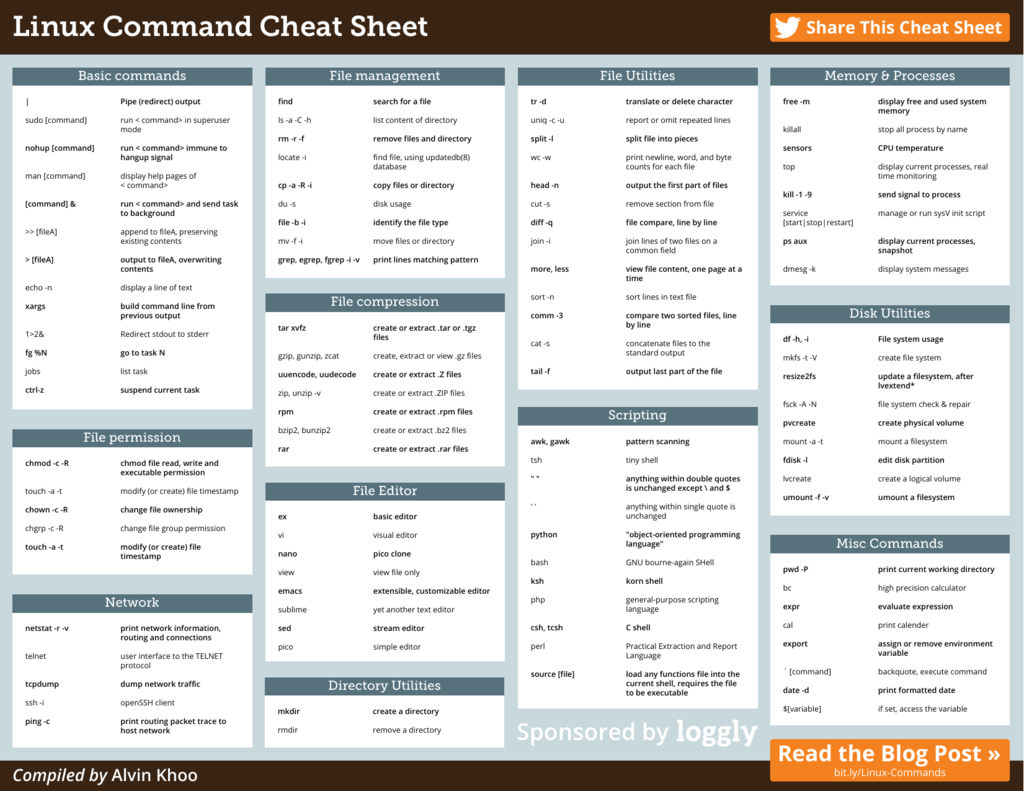


Linux Command Cheat Sheet
When you run $ ls l your output will be something like thisTo supplement the courses in our Cyber Security Career Development Platform, here is a Linux Command Line Cheat Sheet PDF download also available Table of Contents 1 SYSTEM INFORMATION 2 HARDWARE INFORMATION 3 PERFORMANCE MONITORING AND STATISTICS 4 USER INFORMATION AND MANAGEMENT 5 FILE AND DIRECTORY COMMANDS 6 PROCESS MANAGEMENT 7Chmod 777 Owner, group users and other users can read, write and execute the file chmod 700 Owner can read, write and execute the file Group users and other users do not have any



Linux Commands Cheat Sheet Definitive List With Examples



Oscp Cheatsheet Ctf Writeups Security Research
Contribute to sudheerj/Linuxcheatsheet development by creating an account on GitHub Change access The chmod command is used to change the access mode of a file This command is used to set permissions (read, write, execute) on a file/directory for the owner, group and the others groupIn Unix and Unixlike operating systems, chmod is the command and system call which is used to change the access permissions of file system objects (files and directories) It is also used to change special mode flags The request is filtered by the umask The name is an abbreviation of change mode chmod Cheat Sheet List Chmod chart



Linux Command Line Cheat Sheet Kalitut
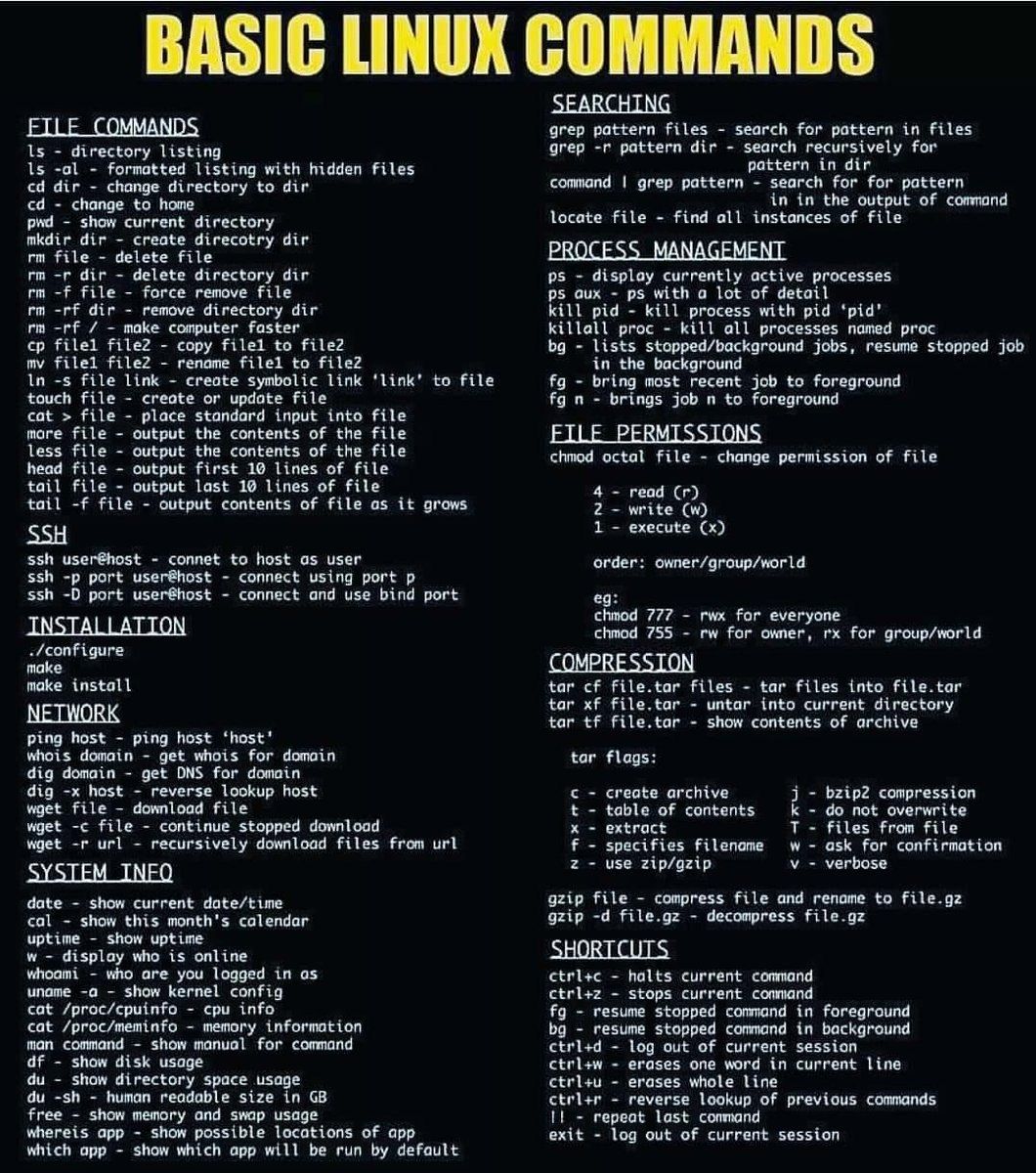


Basic Linux Commands Cheat Sheet Edoardo Vignati



Linux Permissions Files Directories Users And Groups Data Science Tutorials



Unix Linux Command Cheat Sheet Black Mugs Remember The Api



New Bash Linux Cheat Sheet Wallpaper Download Free 40 X 3050px



Bash Cheat Sheet Pages 1 7 Flip Pdf Download Fliphtml5



Linux Test 6 Cheat Sheet By Georgewb13 Download Free From Cheatography Cheatography Com Cheat Sheets For Every Occasion



Linux Configuration Commands Directory Structure And Scripts



Linux Permissions Chart Page 1 Line 17qq Com



Linux Commands For Beginners Cheat Sheet By Dbeauvais Download Free From Cheatography Cheatography Com Cheat Sheets For Every Occasion



Nano Editor Cheat Sheet Page 1 Line 17qq Com



Vtechcoder Linux Command Line Cheatsheet



Unix Commands Cheat Sheet Pdf Drone Fest



Unix Linux Command Cheat Sheet Tumbler oz Remember The Api
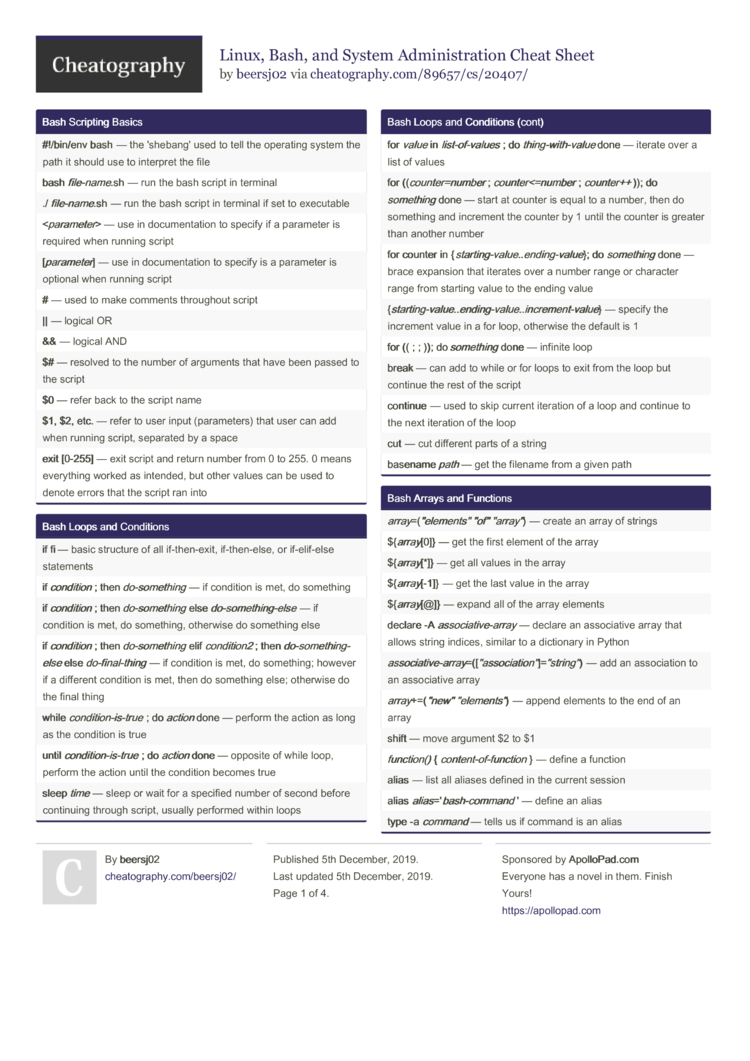


Linux Bash And System Administration Cheat Sheet By Beersj02 Download Free From Cheatography Cheatography Com Cheat Sheets For Every Occasion



Chmod Chown Howto On Debian Ubuntu With Cheatsheet Youtube



Linux Command Line Tips That Every Linux User Should Know



Linux Cli Cheat Sheet Command Line Interface Computer File



The Linux Command Line Cheat Sheet Network World
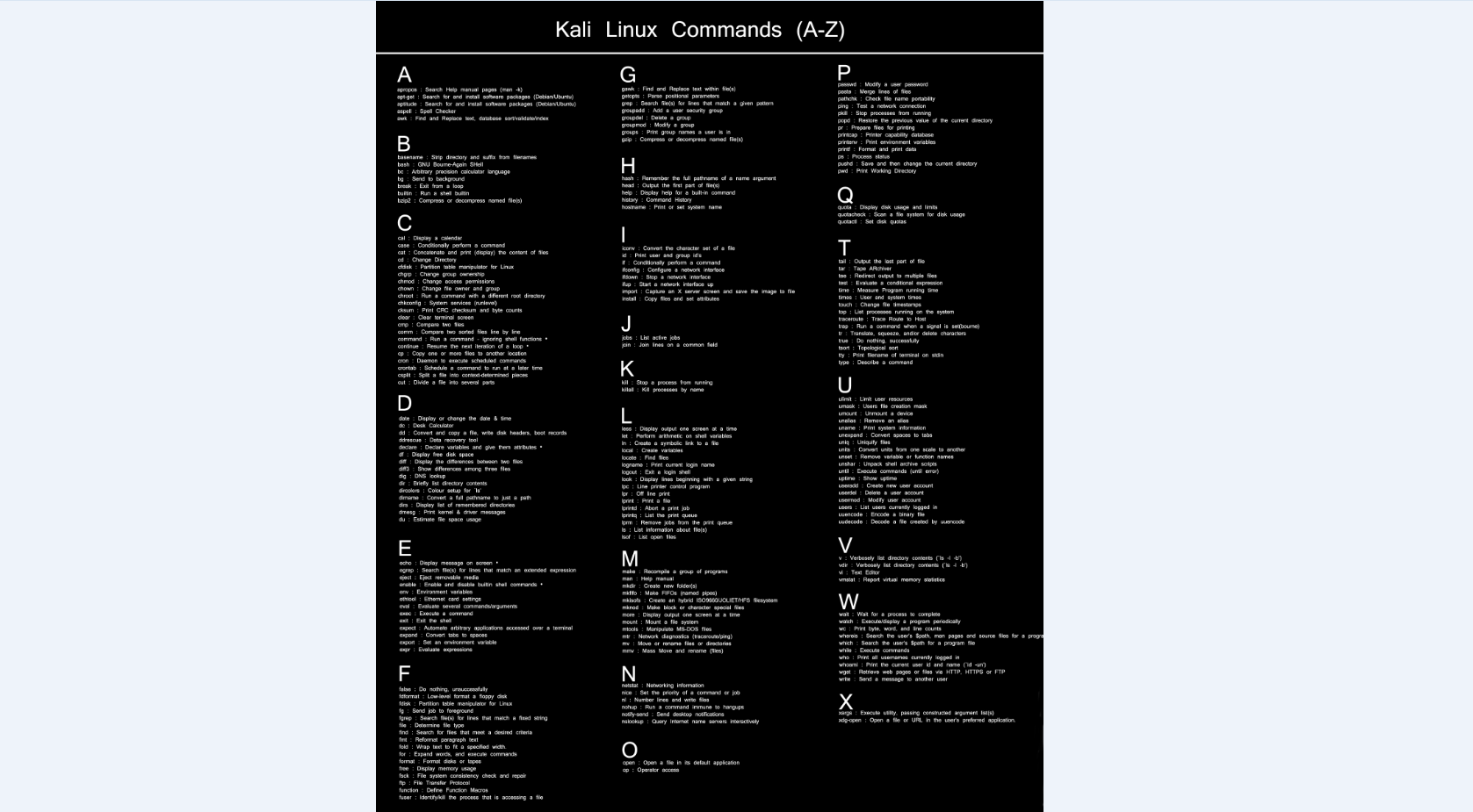


Linux Commands Cheat Sheet



Chmod 660



Common Linux Commands Part Of The Linux For Dummies Cheat Sheet Filename Computer File



Linux System Call Quick Reference Kernel Operating System File System


Git Distributed Version Control System
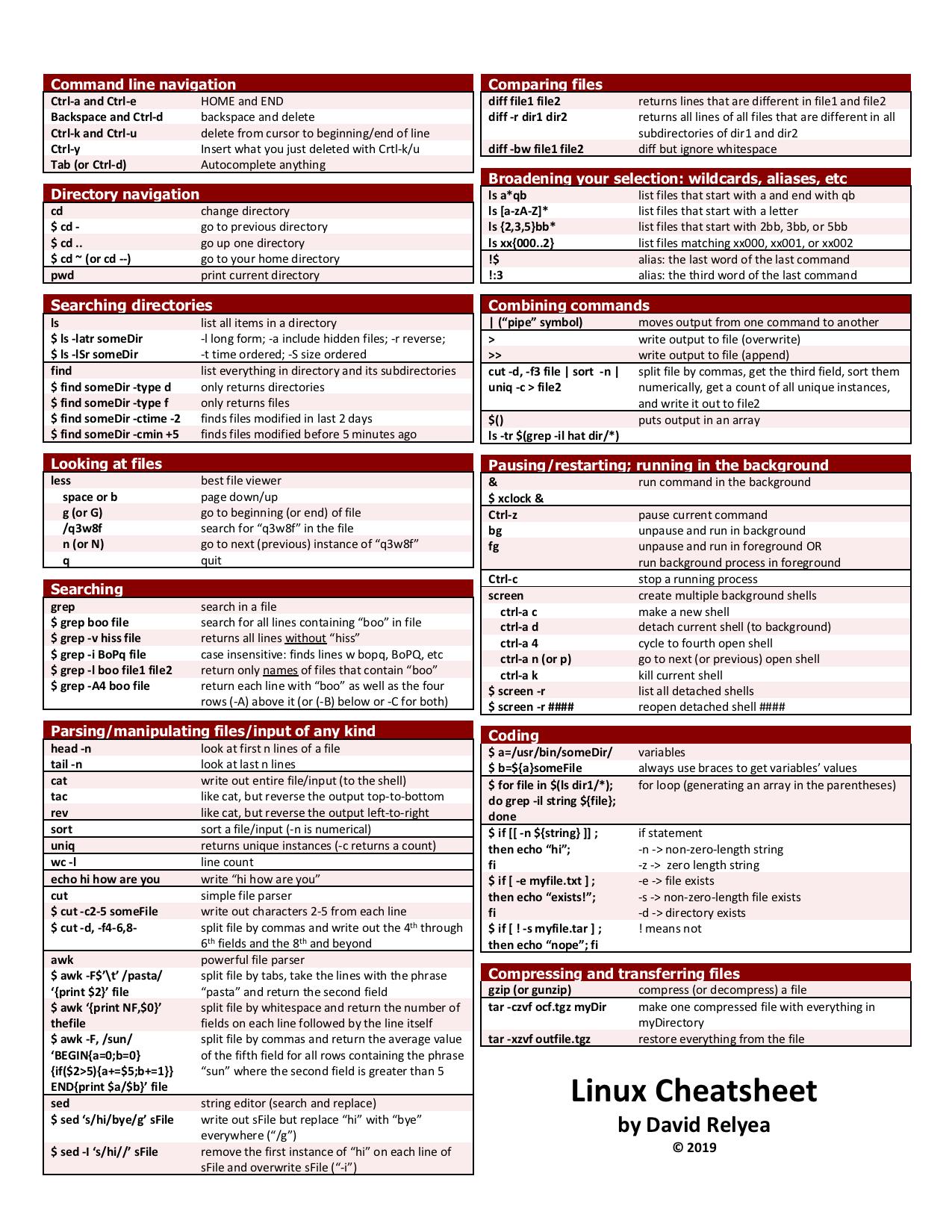


Hardmaru Useful Linux Cheat Sheet For Data Scientists



Linux Chmod Command Summary With Examples Youtube
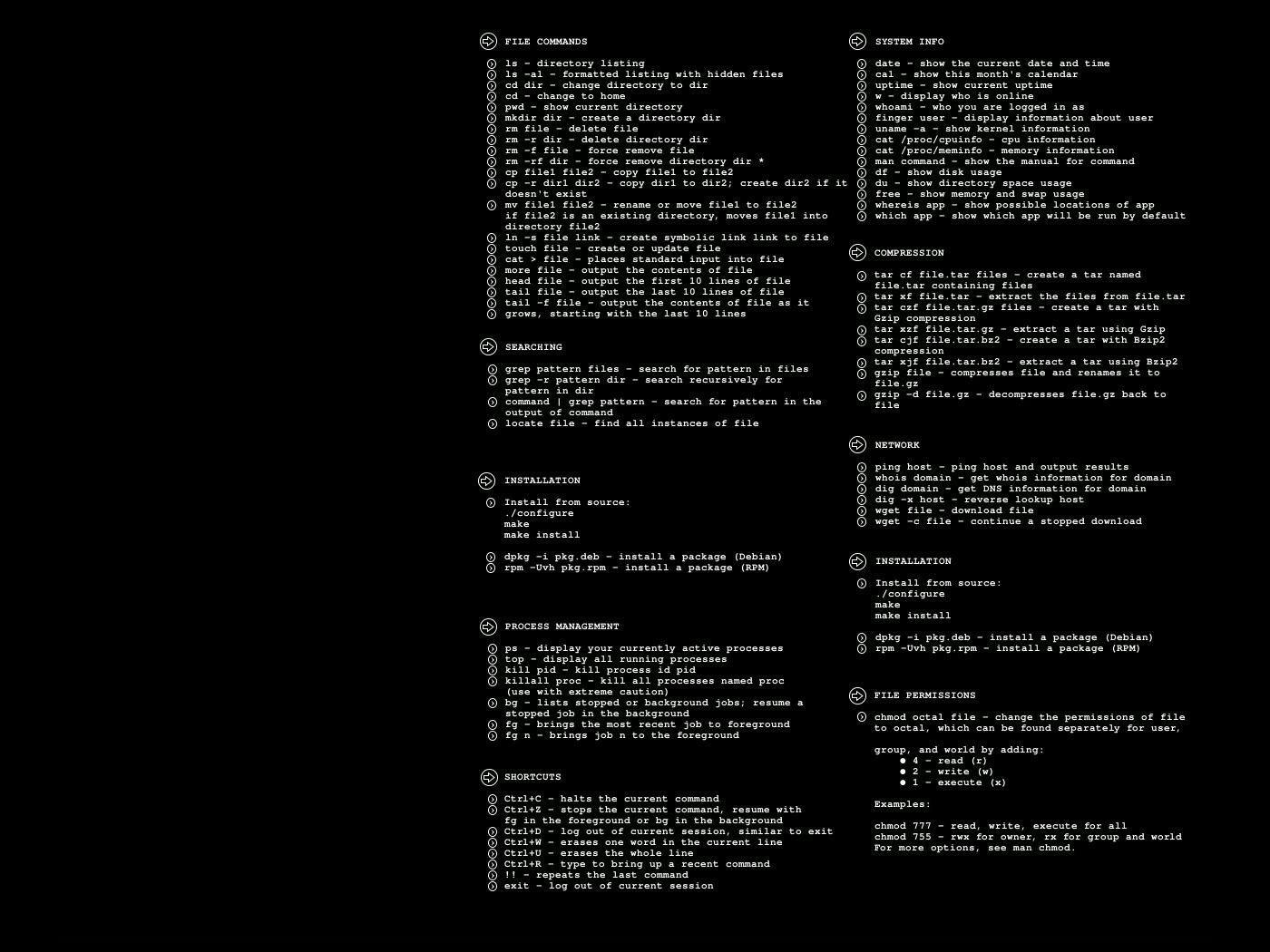


Cheat Sheet Wallpapers Top Free Cheat Sheet Backgrounds Wallpaperaccess
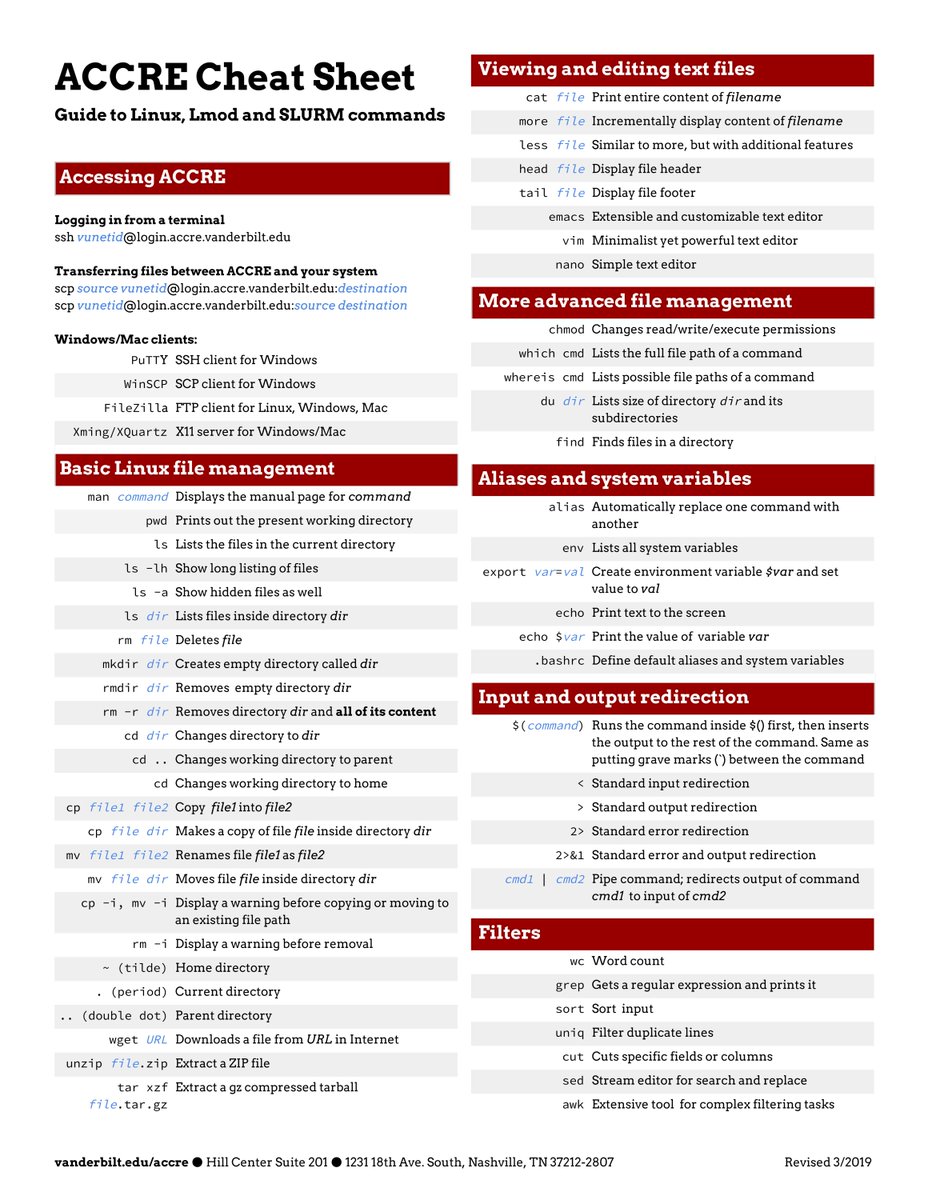


Accre Vanderbilt While We Re Waiting For The Accre Website To Return Here Is The Cheat Sheet Of Linux Lmod And Slurm Commands If Anyone Needs To Look Them Up Over



Pdf Chmod Cheat Sheet Sunny Yiu
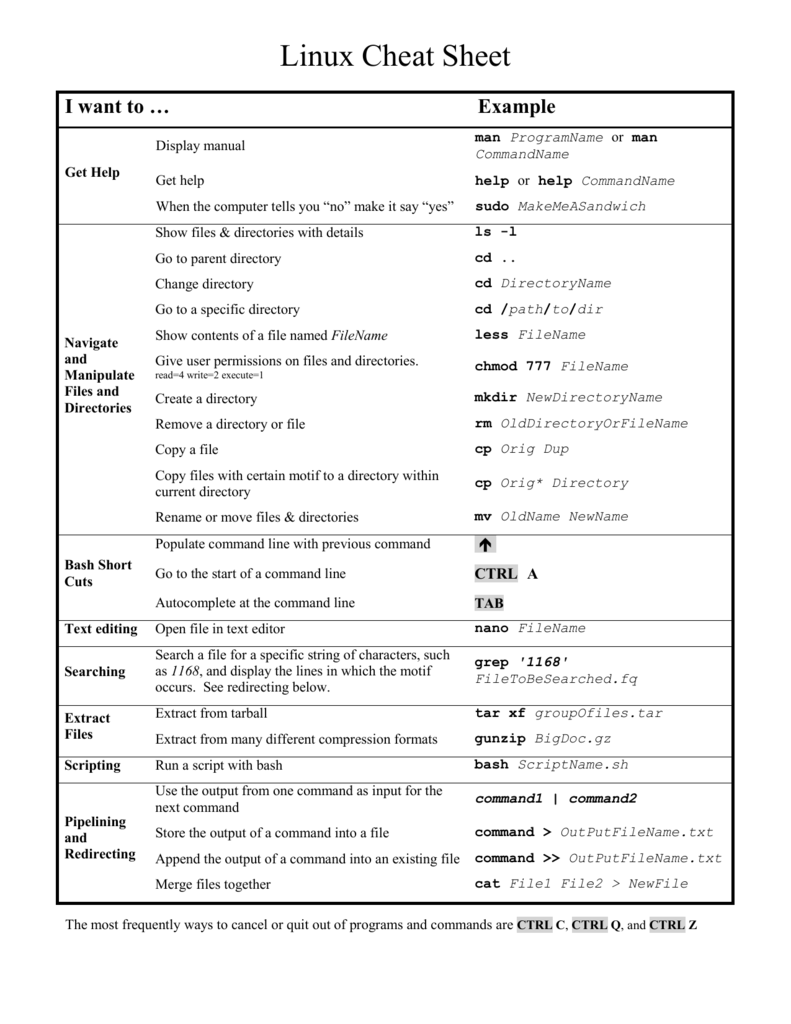


Linux Cheat Sheet



Collection Of Latest Picturess Useful In Pentesting Mrleet
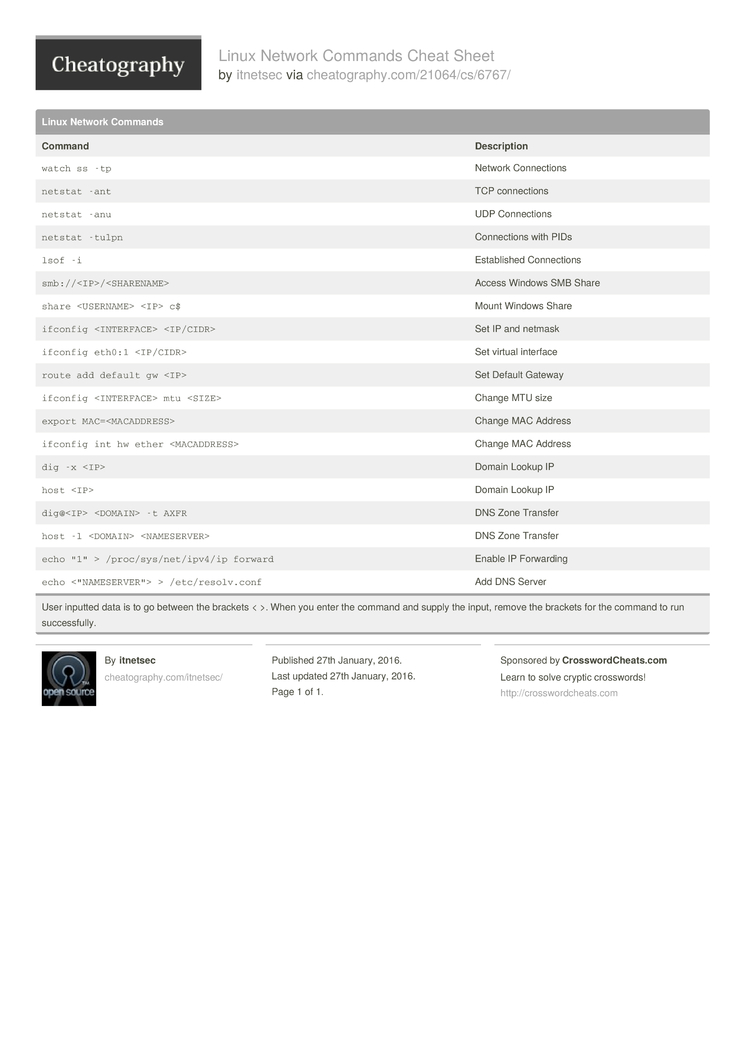


Change Process Name Linux Cheat


Cheat Sheet All Cheat Sheets In One Page



Pl Sql Cheat Sheet Dbas Studocu


Hacker S Cheat Sheet Print It And Stick It At Your Desk Part 1 Credits Compass Security Howtohack


Github Fed Command Line Cheatsheet Unix Command Line Cheatsheet
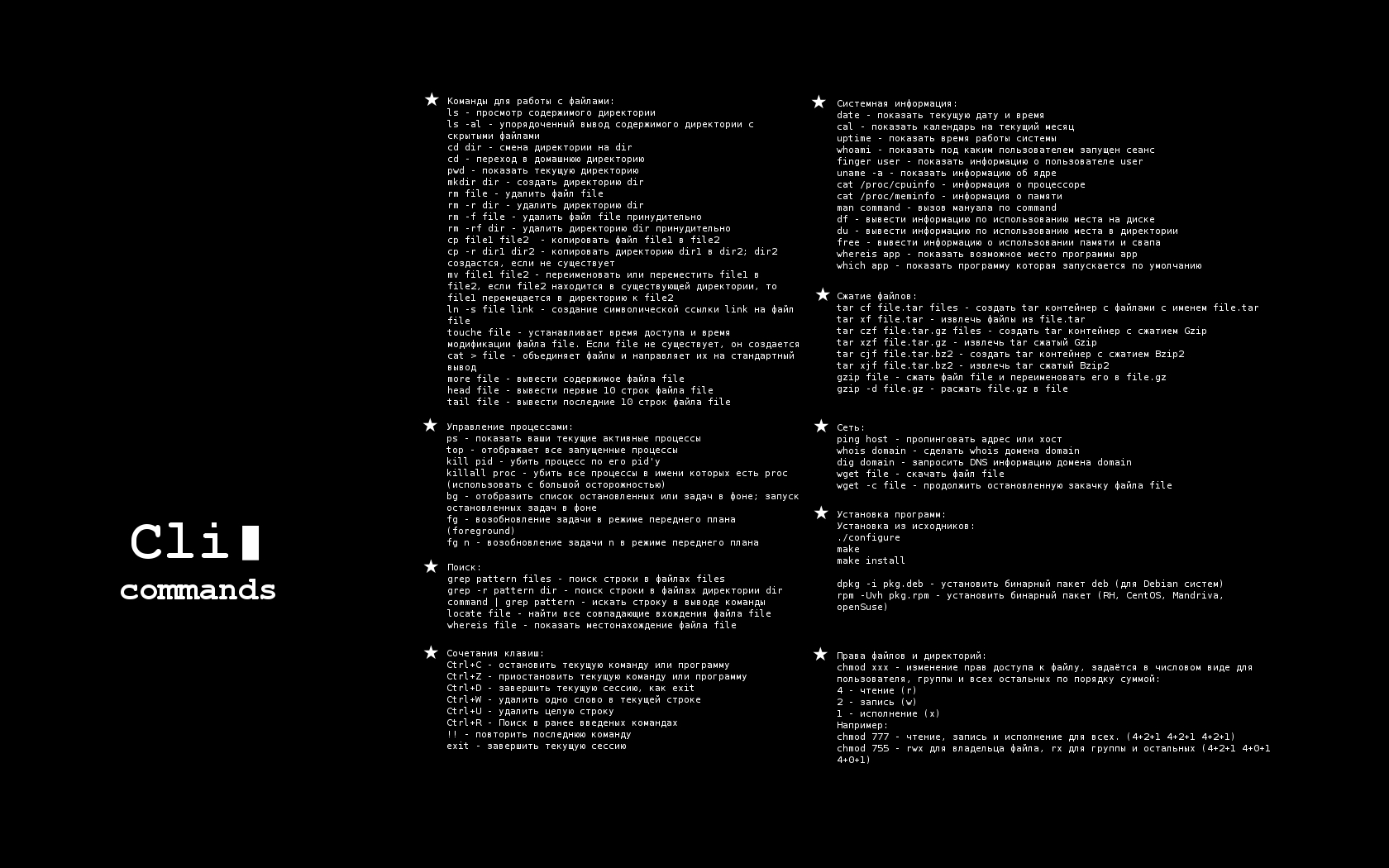


Russian Linux Cheatsheet
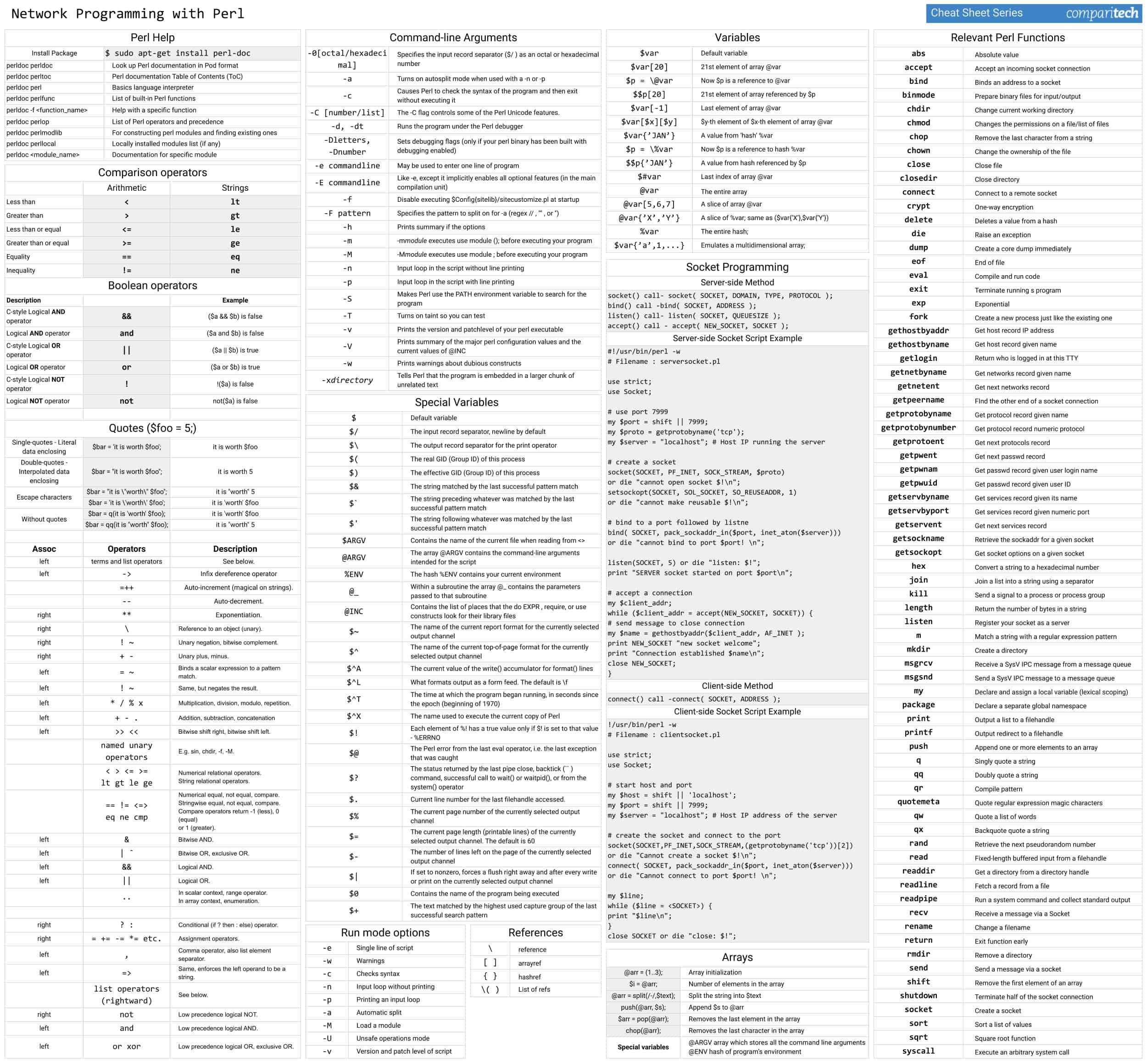


Perl Network Programming Cheat Sheet Downloadable Jpg Pdf


Cheat Sheet All Cheat Sheets In One Page



Unix Command Line Cheat Sheet Page 1 Line 17qq Com



Shell Scripting For Unix And Linux Cheat Sheet From Cheatography Linux Shell Unix Programming Linux



Linux Permissions Chart Yerse



Pin By Dr Stefan Gruenwald On Cheatsheets Computer Programming Cheat Sheets Linux Mint



Hadoop Hdfs Commands Cheat Sheet Linoxide



D 6 Permission Issues And How To Troubleshoot Engineering Libretexts



Linux Command Line Cheat Sheet By Vespoli Download Free From Cheatography Cheatography Com Cheat Sheets For Every Occasion



A Quick Unix Commands Cheat Sheet To The Unix Mac Terminal Computer Programming Linux Computer Coding



Learn Basic Linux Commands With This Downloadable Cheat Sheet
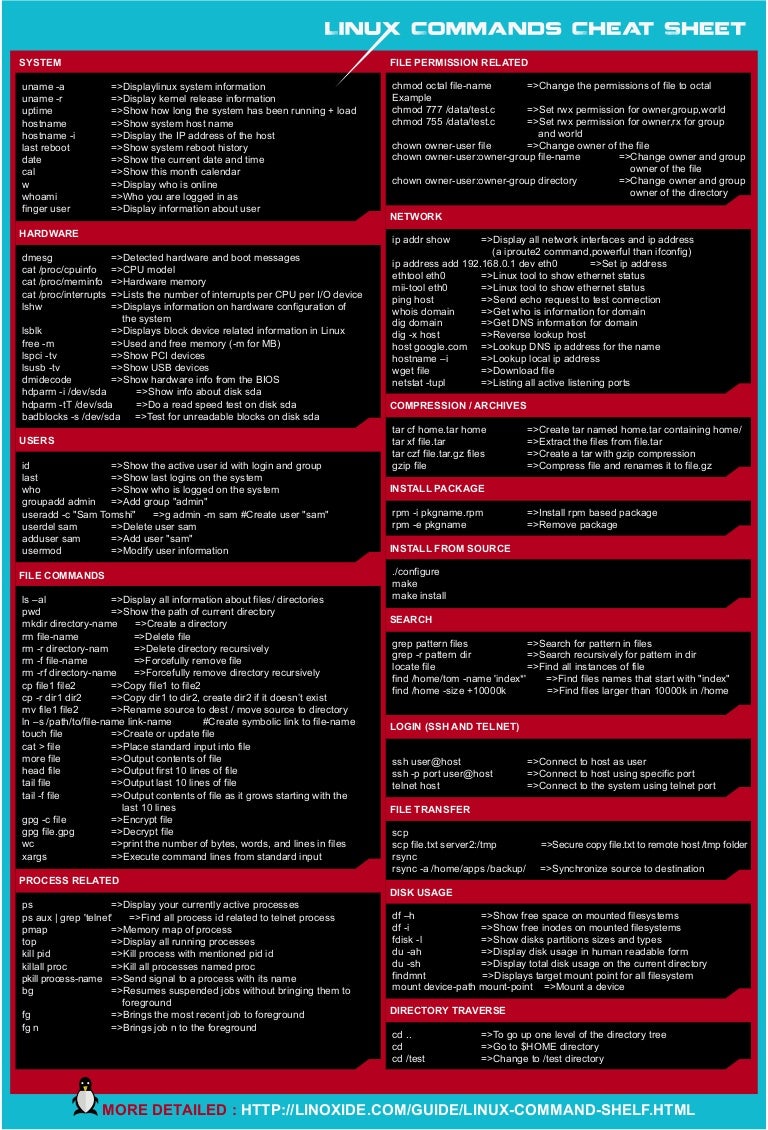


Linux Cheat Sheet


Tip A Cheat Sheet For Those Of You Not Comfortable Using Terminal Jailbreak



Rsync Cheat Sheet By Richardjh Download Free From Cheatography Cheatography Com Cheat Sheets For Every Occasion
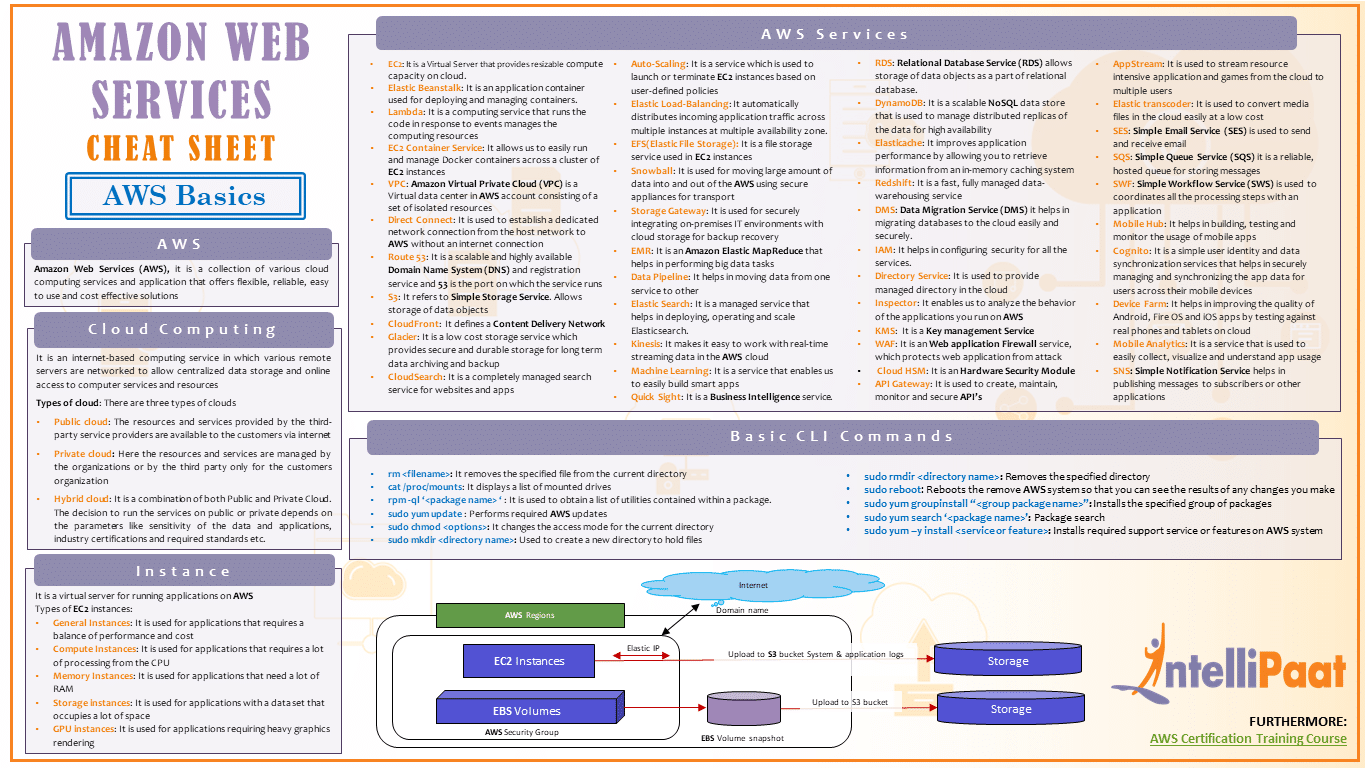


Aws Cheat Sheet Intellipaat Blog



Linux Cheat Sheet By Tnoorman Http Www Cheatography Com Tnoorman Cheat Sheets Linux Cheatsheet Linux Linux Cheat Sheets Study Guide
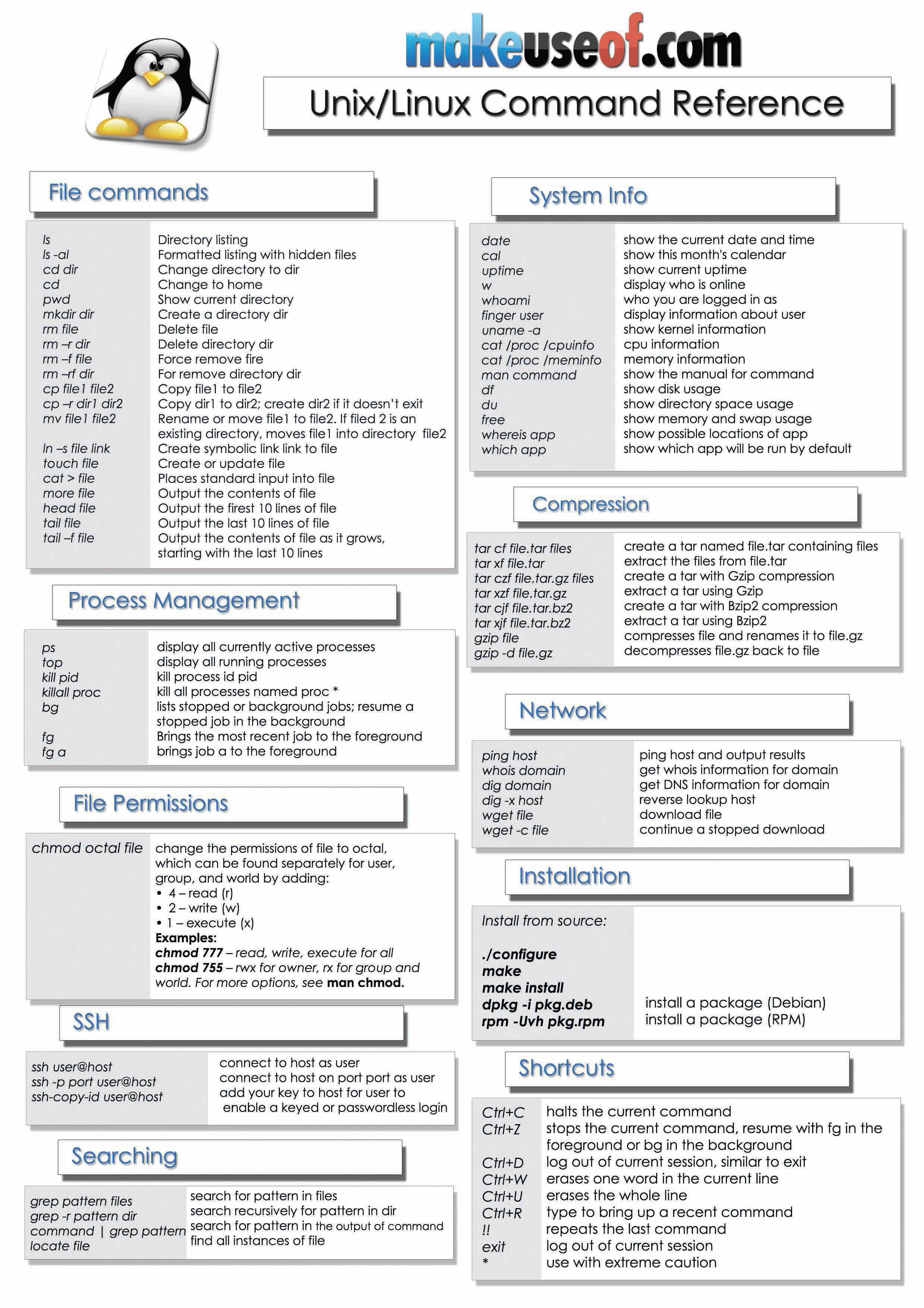


6 Best Linux Unix Command Cheat Sheet



Cyber Technique Kali Linux Commands Cheat Sheet



Soc Linux Cheatsheet Secure Shell Computer File


I Made This Chmod Cheat Sheet And Thought It Might Be Useful Linux4noobs


Cheat Sheet All Cheat Sheets In One Page



Alex Ellis Here Is An Old Cheat Sheet I Made Up For Helping People Learn Docker On Linux



Big Data Hadoop Cheat Sheet Download In Pdf Jpg Format Intellipaat



Shell Tutorial Part 9 Changing Permissions Youtube
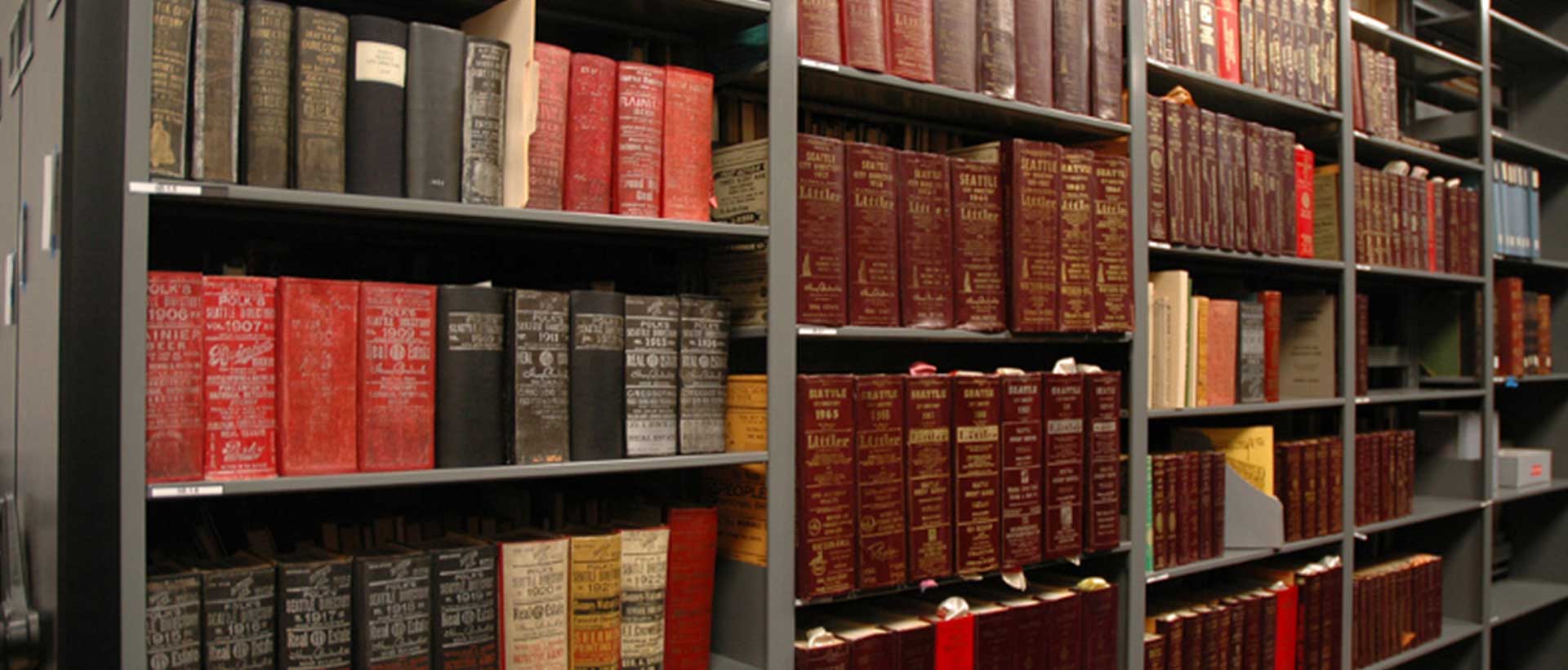


Unix File Permissions Cheat Sheet Bigbridge



0 件のコメント:
コメントを投稿